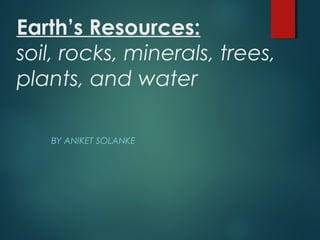
Earth's Resources
- 1. Earth’s Resources: soil, rocks, minerals, trees, plants, and water BY ANIKET SOLANKE
- 2. Who Studies Soil and Rocks? A geologist is a scientist who studies the layers of soil, rocks, and minerals that make up the earth’s surface.
- 3. Natural Resources A natural resource is something found in nature that people can use to meet their needs. Natural resources are not man- made. Here are some natural resources… - rocks - coal - water - soil - trees - plants - air - oil - minerals We will learn about some of these natural resources.
- 4. Soil, Rocks, and Minerals are Natural Resources Soil is the loose top layer of the earth’s surface. All soil comes from rocks and minerals. A rock is a natural solid made of one or more minerals. Minerals are natural solids usually formed as crystals that are found in rocks. All rocks are made of one or more minerals.
- 5. Soil is a Natural Resource Although many of us don't think about the ground beneath us or the soil that we walk on each day, the truth is soil is a very important resource. Think of the Earth as an egg. The shell is a very thin layer. Soil is the thin layer of the Earth’s surface.
- 6. Can you think of any reasons to study soil? We use the soil to grow our food. Some animals graze on it. Other animals live in the ground. We dig deep into the ground for our water wells. I'm sure you can think of many more reasons to study soil….
- 7. 3 Types of Soil Sand – rough, gritty, won’t form a ball Silt – smooth like flour, not sticky or shiny. Clay – soft, shiny, sticky when wet, forms ball, stains hands. When clay is heated, it hardens to make bricks and pottery.
- 8. People Use Soil People need soil to grow food. People use soil to make adobe bricks to build things with.
- 9. Where to Find Rocks A quarry is an open pit.
- 10. Properties of Rocks and Minerals Texture is how much sand, silt, or clay is in the soil. Does it feel gritty, sticky, smooth, silky, moist, or dry? Rocks can be classified by how they look and feel.Rocks can be classified by how they look and feel. Color, texture, and hardness are properties we lookColor, texture, and hardness are properties we look for in a rock or mineral.for in a rock or mineral. • Color •Hardness is tested by scratching a rock with your fingernail, a penny, and a nail.
- 11. People Use Rocks People use rocks to build houses and roads. People use rocks to make walls and walkways. People use rocks to make sculptures. Most sculptures are made by carefully chipping away rock and making it smooth or rough.
- 12. Mount Rushmore Mount Rushmore shows the faces of four great presidents: George Washington, Thomas Jefferson, Theodore Roosevelt, and Abraham Lincoln. From 1927 to 1941, 400 workers sculpted this memorial to represent the first 150 years of American history. It is located in Keystone, South Dakota.
- 13. Plants are Natural Resources Plants have many uses… They make surroundings more beautiful. Trees are used for wood to build houses and make furniture. Trees are also used to make paper. Fabric is made from plants, like cotton. Branches from plants are used for fuel to make a fire. Plants are used for food: fruits, vegetables and grains. Plants are used to make cooking oils, herbs, and spices for seasoning foods. Plants are also used to make medicines. Some plants are even used to make rubber for tires.
- 14. Water is a Natural Resource People use water in many ways… People, plants, and animals need water to live. People use water for drinking and cooking. Water is used for having fun, to swim or cool-off. Water is also used for bathing and cleaning things. Our supply of water will never run out. WaterOur supply of water will never run out. Water covers about 70% of the Earth. Remember,covers about 70% of the Earth. Remember, water is always being recycled.water is always being recycled.
- 15. Congratulations! You have learned that soil, rocks, minerals, plants, and water are natural resources. You have also learned how people use rocks, soil, plants, and water. Would you like to be a geologist?
- 16. Thank you